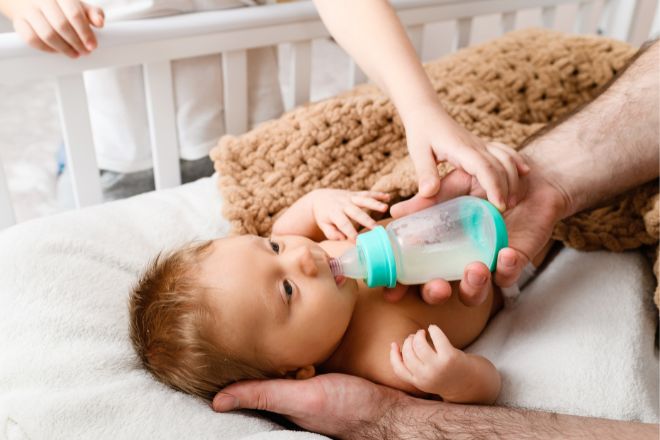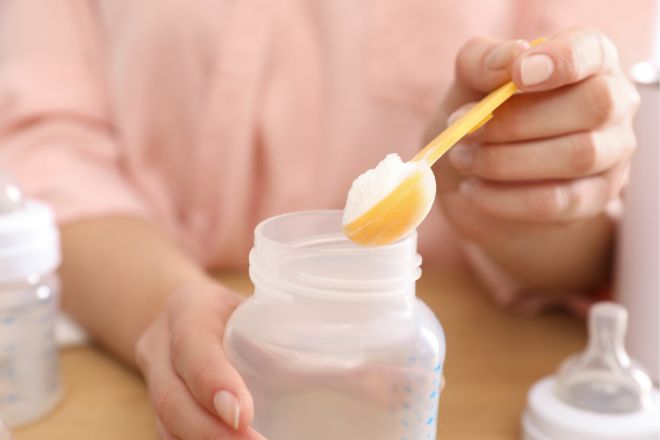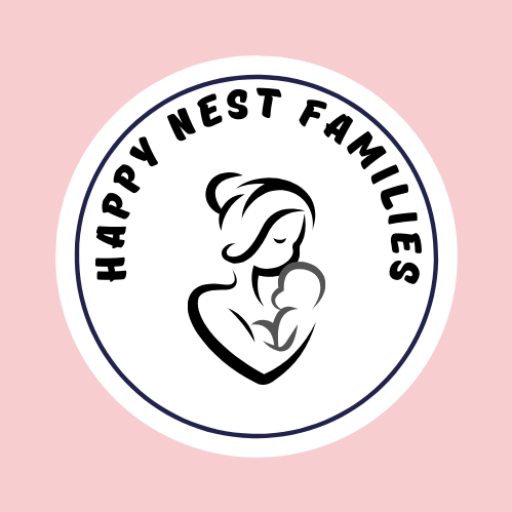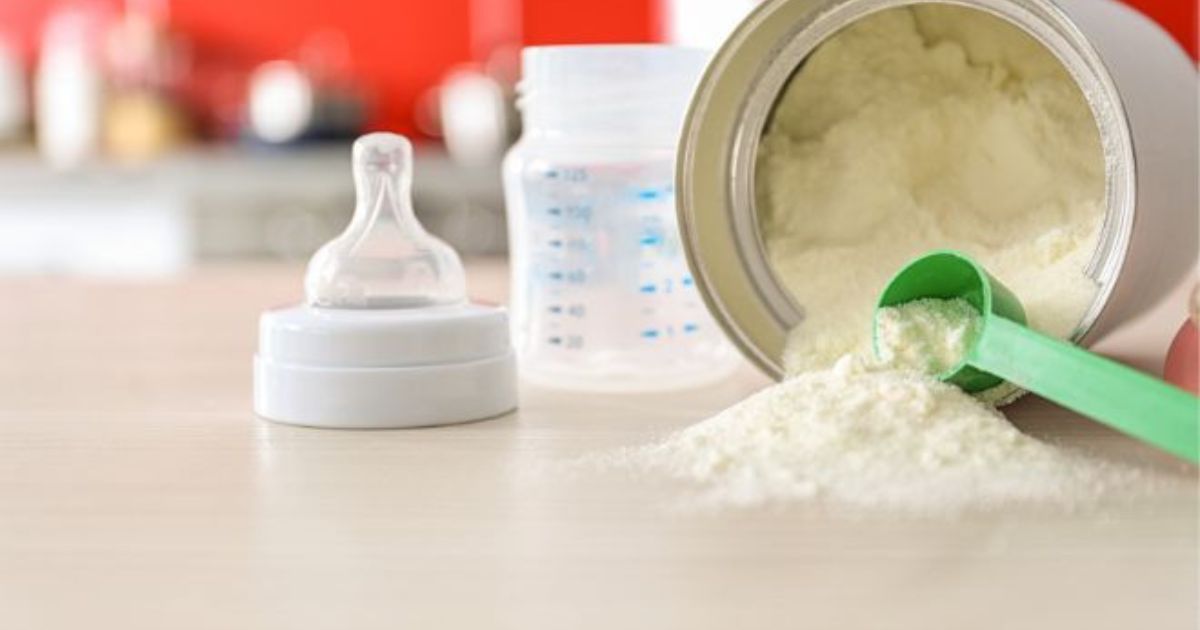Table of Contents
Newborn Formula Feeding Tips: Start newborn formula feeding with a clean bottle and the right formula temperature. Feed your baby on demand or every 2-3 hours.
Welcoming a newborn into your family is a journey filled with joy and new challenges, one of which is mastering the art of formula feeding. Ensuring your infant gets the right nutrition is crucial for their development. Whether you’ve chosen to formula feed from the start, are supplementing, or are transitioning from breast milk, understanding the basics of newborn formula feeding can make this aspect of parenting smoother and more enjoyable.
The process involves more than just preparing the bottle; it’s about recognizing your baby’s hunger cues, knowing how much they need, and being attentive to their reactions during and after feedings. This guide will provide you with practical tips to confidently nourish your newborn with formula.
Choosing The Right Formula
Feeding your newborn is a special time. It’s also a time full of decisions, like choosing the right formula. This choice can seem hard, but we’re here to help. Let’s dive into how to pick the best formula for your baby.
Understanding Your Options
Finding the best formula for newborns starts with knowing what’s out there. You have a few main types:
- Cow’s milk-based formulas are the most common. They work well for most babies.
- Soy-based formulas are an option if your baby can’t have dairy.
- Specialized formulas are for babies with specific needs, like allergies.
Think about what might fit your baby best. You also want to look at the formula’s ingredients. Some have added DHA and ARA. These are good fats found in breast milk. They help with brain and eye development.
| Type of Formula | Best For |
|---|---|
| Cow’s milk-based | Most babies |
| Soy-based | Babies with dairy issues |
| Specialized | Babies with allergies or other special needs |
Remember, the best formula for newborns is the one that meets their unique needs.
Consulting With A Pediatrician
Always talk to a pediatrician before deciding. They can help you pick the best formula for newborns. Here’s why:
- Expert advice: They know about baby nutrition and health.
- Special needs: They can identify if your baby needs a special formula.
- Peace of mind: It’s comforting to have a professional’s opinion.
Prepare questions for your pediatrician. Ask about types of formula and what they recommend. Also, discuss any concerns like allergies or digestion issues. Your pediatrician’s advice is valuable in making the right choice.
How To Feed Formula To A Newborn?
Feeding formula to your baby is more than just mixing water and powder. Here are some steps:
- Wash your hands. Always start with clean hands to keep germs away.
- Read the label. Follow the formula’s instructions for mixing.
- Use safe water. Boil water if you’re not sure it’s safe, then cool it down.
- Check the temperature. The formula should be warm, not hot. Test it on your wrist.
- Feed your baby. Hold your baby close and enjoy this moment.
Remember, feeding time is also bonding time. Look into your baby’s eyes and talk to them. It makes feeding special. Also, know that it’s okay to ask for help. Whether it’s your pediatrician or a family member, support is there.

Preparing Formula Safely
Feeding your newborn is an important task that sets the foundation for their growth. The right approach to how to prepare formula for newborns is crucial for their health. Ensuring that the formula is safe and nutritious requires careful preparation. Let’s discuss the steps to prepare the formula safely for your little one’s needs.
Sterilizing Equipment
To ensure your baby’s safety, it’s vital to sterilize feeding equipment before each use. Germs can easily grow on bottles and nipples, posing a risk to your baby’s health. Here’s how to keep your equipment clean:
- Wash your hands thoroughly with soap and water.
- Clean all feeding items in hot, soapy water. Use a clean bottle brush for the inside of bottles and nipples.
- Rinse items with clean water.
Next, choose a sterilization method:
- Boiling: Place all items in a large pot. Cover them with water. Bring water to a boil. Keep boiling for at least 5 minutes.
- Steam Sterilizer: Use an electric steam sterilizer or microwave steam sterilizer according to the manufacturer’s instructions.
- Cold Water Sterilization: Use a sterilizing solution or tablets in cold water. Soak items for at least 30 minutes.
After sterilization, keep the feeding equipment in a clean, sealed container until use.
Following Mixing Instructions
Proper mixing is key to preparing formula that is both safe and provides the right nutrition. Follow these steps to mix formula correctly:
- Read the label on the formula’s packaging. It has precise instructions.
- Use the scoop provided to measure the powder. Level off the excess.
- Fill the bottle with the correct amount of water. Always add water before powder.
- Add the measured powder to the water. Secure the nipple and cap.
- Shake the bottle well. This helps mix the formula without any lumps.
- Test the temperature on your wrist. It should feel warm, not hot.
Remember these important tips:
| Do | Don’t |
|---|---|
| Use the exact amount of powder and water as instructed. | Add extra water or powder to stretch the formula. |
| Check the expiry date on the formula. | Use formula past its expiry date. |
| Discard any formula left in the bottle after a feed. | Save leftover formula for the next feed. |
By following these steps, you ensure your newborn receives the right balance of nutrients in a safe, clean feeding environment.
Feeding Schedule
Feeding a newborn is an essential part of baby care, and for those who opt for formula, understanding the feeding schedule can make the process smoother. From recognizing when your baby is hungry to establishing a routine, a well-planned newborn formula feeding approach ensures your baby thrives. Let’s dive into the best practices for feeding your formula-fed newborn.
Establishing A Routine
Creating a consistent feeding routine helps your baby feel secure and aids in digestion. In the first few weeks, newborns typically need to feed every 2-3 hours. As they grow, the intervals may extend. Here are some tips for establishing a solid feeding routine:
- Track feedings: Note down the time and amount of formula to monitor your baby’s habits.
- Observe sleep patterns: Align feedings with your baby’s natural sleep cycles when possible.
- Stay flexible: Be ready to adjust the schedule based on your baby’s growth and needs.
A routine doesn’t mean being rigid. It’s about finding a rhythm that works for both you and your baby.
Recognizing Hunger Cues
Understanding your baby’s signals for hunger can prevent overfeeding and fussiness. Early cues might include:
- Moving hands to mouth
- Turning head towards the bottle
- Opening mouth and sticking out tongue
Waiting for crying, a late hunger cue, can make feeding harder. Feed your baby at the first sign of hunger to keep them calm and content.
What Is The Routine Of Newborn Formula-Feeding?
The newborn formula feeding routine varies with age and individual needs. Generally, you can expect to feed your newborn:
| Age | Feeding Frequency | Formula Amount |
|---|---|---|
| 0-1 Month | Every 2-3 hours | 2-3 ounces |
| 1-2 Months | Every 3-4 hours | 4-5 ounces |
| 2-6 Months | Every 4-5 hours | 5-6 ounces |
Remember to consult with your pediatrician to decide “how much formula should I feed my newborn” as individual needs can vary.

Feeding Techniques
Newborn formula feeding is an essential part of their early growth. For parents using formula, understanding the best feeding techniques is key. These tips help ensure your baby is comfortable, well-fed, and happy. With the right approach, newborn formula feeding can be a smooth process for both you and your little one.
Holding The Baby
When it comes to feeding your newborn, the way you hold them makes a big difference. A proper hold can make feeding time a soothing experience. Here are some tips:
- Always support the head and neck. Newborns cannot hold their heads up on their own.
- Position the baby at a slight incline. This helps with digestion and prevents ear infections.
- Switch arms halfway through. This stimulates brain development by engaging both sides of the body.
Remember to make eye contact and bond during this time. It’s not just about food, it’s about love and comfort too.
Burping Strategies
Burping is a must after feeding to help release any air your baby swallows. Here are several effective burping strategies:
- Over the shoulder: Hold your baby against your chest, their chin resting on your shoulder. Pat or rub their back gently.
- On your lap: Sit the baby on your lap, leaning forward slightly, supporting their chest and head with one hand. Gently pat their back with the other hand.
- Face down across your lap: Lay your baby across your knees, face down, supporting their chin and jaw with one hand. Pat or rub their back with the other hand.
Listen for a burp, indicating that the air has been expelled. If the baby doesn’t burp right away, try a different position.
How Many Hours Should I Give My Newborn Formula?
Feeding intervals are crucial for a newborn’s health. Here’s a simple guide:
| Age | Feeding Frequency | Amount per Feed |
|---|---|---|
| 0-1 month | Every 2-3 hours | 2-3 ounces |
| 1-2 months | Every 3-4 hours | 4-5 ounces |
| 2-6 months | Every 4-5 hours | 5-6 ounces |
It’s best to feed on demand, meaning when your baby shows signs of hunger. Crying, sucking motions, and putting their hands to their mouth are common signs. Keep a close eye on your baby’s hunger cues and try to feed before the crying starts.
Proper Bottle Positioning
Newborn formula feeding is an essential part of their growth. One key aspect to consider is Proper Bottle Positioning. This ensures your baby feeds comfortably and safely. Let’s explore some vital tips to get it right every time.
Avoiding Air Intake
When feeding with a bottle, it’s crucial to keep air intake to a minimum. Air can lead to discomfort and fussiness in babies. Here’s how to minimize it:
- Hold the bottle at an angle – Tilt it so that the formula fills the neck of the bottle and covers the nipple. This prevents air bubbles from forming.
- Use the right nipple – Choose a nipple with a flow rate suitable for your baby’s age. A slow-flow nipple is ideal for newborns.
- Check for bubbles – Watch for air bubbles rising in the bottle. If you see them, gently tap the bottle to let them rise to the top.
Keep in mind these simple steps:
| Step | Action |
|---|---|
| 1 | Position the bottle correctly. |
| 2 | Select the appropriate nipple. |
| 3 | Monitor for air bubbles. |
Encouraging Proper Latch
To ensure your baby gets the most from bottle-feeding, a proper latch is key. A good latch helps with digestion and makes feeding times more serene. Follow these steps:
- Touch the nipple to the baby’s lip – This encourages your baby to open their mouth wide.
- Wait for a wide mouth – Gently insert the nipple only when your baby’s mouth is open wide.
- Check for a seal – There should be a tight seal around the nipple, with no sounds of air.
Remember these points to aid a proper latch:
| Point | Detail |
|---|---|
| Lip Position | Baby’s lips should be flared outwards, not tucked in. |
| Chin and Nose | Baby’s chin should touch the bottle, nose should be clear. |
| Swallowing Sounds | Listen for soft, rhythmic swallowing, not gulping or gasping. |

Signs Of Adequate Feeding
Parents often worry if their newborn gets enough formula. It’s a common concern, but certain signs can ease your mind. A baby who feeds well will show clear, reassuring signals. Let’s explore these signs, making sure your little one thrives right from the start.
Monitoring Weight Gain
Babies grow at remarkable speeds. Weight gain is a solid sign your newborn is feeding well. In the first few days, a slight drop is normal. But, after that, you should see a steady increase. Here’s what to watch for:
- Initial weight loss: Babies often lose up to 10% of their birth weight in the first week. It’s normal.
- Return to birth weight: By 2 weeks, most reach their original weight.
- Consistent gain: After the first two weeks, expect about 150-200 grams (5-7 ounces) of weight gain per week.
Keep track of their progress with regular weigh-ins. Your pediatrician will do this during check-ups. But, you can also use a home baby scale for in-between visits. The table below shows a simple tracking method:
| Week | Expected Weight Range | Notes |
|---|---|---|
| 1 | 5-7% below birth weight | Weight loss is typical |
| 2 | Back to birth weight | Sign of good health |
| 3-4 | +150-200g per week | Steady gain means adequate feeding |
Observing Diaper Output
Diapers tell a story. A newborn’s output is a direct sign of intake. Here’s what to expect:
- Wet diapers: At least 5-6 full ones daily after the first week.
- Stool frequency: Newborns often have 3-4 stools per day, or more with some formulas.
- Color and texture: Mustard yellow, soft, and seedy is common for formula-fed babies.
Keep a diary to track changes. It’s useful for pediatrician visits. If diapers are too dry or stools too infrequent, it might signal an issue. Below is a simple chart to help:
| Day | Wet Diapers | Stool Characteristics |
|---|---|---|
| 1 | 1-2 | Greenish-black, tarry |
| 5 | 5-6+ | Yellow, soft, seedy |
| 10 | 6+ | Consistent with day 5 |
Remember, each baby is unique. Some might have more wet diapers or different stool patterns. That’s okay. Use these guidelines as a reference and always consult with your pediatrician for personalized advice.
Dealing With Common Issues
Newborn formula feeding can be a smooth journey with the right tips. But, like any journey, there may be bumps along the way. Dealing with common issues early on helps ensure your baby stays happy and healthy. This section offers guidance on overcoming some typical feeding challenges.
Reflux And Spit-up
Seeing your baby spit up can be alarming, but it’s often a normal part of development. Reflux happens when milk comes back up from the baby’s stomach. Here are some tips to manage it:
- Feed in an upright position: Keep your baby’s head higher than their stomach.
- Burp frequently: Gently pat your baby’s back to release the trapped air.
- Avoid overfeeding: Give smaller amounts more often.
Keep an eye on your baby’s spit-up. If it’s frequent or your baby seems uncomfortable, consult a pediatrician. They might suggest a special formula designed for this issue.
Constipation Concerns
Switching from breast milk to formula can sometimes lead to constipation. Your baby’s stools might become harder and less frequent. To ease their discomfort:
- Check the formula preparation: Follow the instructions precisely. Incorrect mixing can cause digestive issues.
- Offer extra water: If your pediatrician agrees, a little extra water can help.
- Gently move your baby’s legs: Bicycle motions can stimulate their bowels.
If constipation persists, your doctor may suggest a different formula or a mild laxative for babies.
Is It Safe To Give Both Breastmilk And Formula?
Many parents wonder about switching from breast milk to formula or combining both. It’s safe to do so and can be quite beneficial. Here’s why:
- Flexibility: Combining both allows parents to share feeding responsibilities.
- Supplemental nutrients: Formula can provide nutrients that might be low in breast milk.
- Convenience: Formula-feeding can be easier when you’re out and about.
Always ensure that both feeding methods are well-established. This helps prevent nipple confusion and maintains milk supply if you’re breastfeeding.

Transitioning To Solid Foods
Feeding your baby is an exciting journey. It starts with formula and moves to solid foods. This change is big for little tummies. Let’s make it smooth and happy for both of you.
Introducing Solid Foods
Starting solids is a big step for your baby. It’s not just about eating. It’s about tasting, touching, and learning. Most babies are ready at about 6 months. Look for signs like sitting up, showing interest in your food, and not pushing food out with their tongue.
- Start simple. Begin with single-ingredient foods. Think pureed fruits, veggies, and cereal. Wait 3-5 days before introducing new foods to check for allergies.
- Keep it soft. Baby’s first foods should be smooth and easy to swallow. Mash or blend well.
- Let them play. Mealtime is also playtime. Let your baby explore textures and tastes. It’s messy but important.
| Age | Food Suggestions |
|---|---|
| 6 months | Pureed apples, bananas, sweet potatoes |
| 7-8 months | Finely chopped vegetables, soft fruits, finger foods |
| 9-12 months | More variety, including meat, dairy, and grains |
Remember, each baby is different. Go at your baby’s pace. Some days they might eat more, some days less. That’s okay.
Gradual Weaning From Formula
Weaning is not just about stopping formula. It’s about moving to a new way of eating and drinking. It’s gradual. Start by replacing one newborn formula feeding with a solid meal. Over time, add more solid meals.
- Mix it up. Combine formula with solid food meals. It makes the change easier.
- Stay flexible. Some babies switch easily. Others need more time. Follow your baby’s lead.
- Introduce a cup. By 6-9 months, offer water in a sippy cup. It helps them learn.
During weaning:
- Keep offering a variety of foods. It helps them get used to different tastes.
- Don’t rush. Let your baby enjoy food. It builds healthy eating habits.
- Stay calm. Your baby can sense stress. Keep mealtime happy and relaxed.
Remember, weaning is a journey. It takes time and patience. Your baby will let you know when they’re ready for more solids and less formula. Trust them, and trust yourself. You’re doing great.
Storing And Handling Formula
Newborn formula feeding requires to take careful steps to ensure safety and health. Storing and handling formulas correctly is vital. From keeping bottles clean to making sure the formula stays fresh, every detail counts. This section covers essential tips to properly store and handle baby formula, keeping your little one happy and well-fed.
Proper Storage Guidelines
Keeping newborn formula feeding safe starts with proper storage. Always check the expiration date before using. Unopened formula cans should be kept in a cool, dry place. Avoid extreme temperatures which can spoil the formula. Follow these guidelines:
- Room Temperature: Unopened powder formula can stay at room temperature. Use within a month for best quality.
- Refrigerator: Once opened, liquid formula and powder formula mixed with water should be stored in the refrigerator immediately.
- Freezer: Never freeze formula. It can cause the ingredients to separate and degrade.
For opened formula:
| Type of Formula | Storage Location | Use-By Time |
|---|---|---|
| Powder | Refrigerator | 24 hours |
| Liquid Concentrate | Refrigerator | 48 hours |
| Ready-to-Feed | Refrigerator | Per manufacturer’s instructions |
Remember to always seal containers tightly and label bottles with the date and time of preparation.
Traveling With Formula
When you’re on the go, keeping formula safe and ready for your baby is a top priority. Plan ahead and keep these tips in mind:
- Insulated Bags: Use insulated bags with ice packs to keep formula cold.
- Portable Bottle Warmers: Consider a portable bottle warmer for heating.
- Pre-measured Powder: Bring pre-measured powder in a separate container. Add water when needed.
For longer trips, here’s a helpful checklist:
- Clean, sterilized bottles and nipples
- Enough formula for the journey plus extra
- Cold water if using powder or liquid concentrate
- Disposable bottle liners for easy clean-up
Always keep prepared formula out of direct sunlight and away from heat sources prepared formula within one hour if kept at room temperature. If not used within this time, store it in the refrigerator and use it within 24 hours. Safe travels mean a happy baby!

Seeking Support And Resources
Embarking on the journey of newborn formula feeding can bring a mix of emotions. Parents may feel overwhelmed with choices, schedules, and the desire to do everything right. A strong support system and the right resources can make all the difference. This section delves into how to seek out support and find the best information to guide you through the process of formula feeding your infant.
Joining Parenting Groups
Parenting groups are a lifeline for new parents navigating the world of formula feeding. These communities provide a sense of belonging and an opportunity to share experiences. They offer practical advice and emotional support that can be invaluable during the early stages of parenthood. Here’s how to benefit from parenting groups:
- Shared Experiences: Hearing from others in similar situations provides reassurance and tips.
- Local Meetups: They offer a chance to see feeding techniques in action and discuss products.
- Online Forums: These platforms are great for asking questions at any hour, particularly during late-night feeds.
Consider the following table to find the right type of group for your needs:
| Type of Group | Benefits | Example Platforms |
|---|---|---|
| In-Person Support Groups | Direct interaction, live demonstrations | Hospital programs, community centers |
| Online Communities | 24/7 access, wide range of experiences | Social media groups, parenting forums |
| Local Clubs | Networking, playdates, local resources | Mommy and Me classes, library groups |
Accessing Reliable Information
When it comes to newborn formula feeding, accurate information is key. With so much advice available, it’s vital to identify trustworthy sources. Look for evidence-based information from reputable organizations. Here are steps to ensure the information you receive is reliable:
- Consult Healthcare Providers: Pediatricians can offer tailored advice for your baby’s needs.
- Research: Use established medical websites and peer-reviewed journals for up-to-date studies.
- Read Labels: Understand the ingredients and nutrition in different formula brands.
Use the resources below to start your research on formula feeding:
| Resource | Description | Website |
|---|---|---|
| American Academy of Pediatrics | Guidelines and articles on infant nutrition | aap.org |
| Centers for Disease Control and Prevention | Tips on formula preparation and storage | cdc.gov |
| World Health Organization | Global standards for infant feeding | who.int |
How Long Does It Take For A Newborn To Get Used To Formula?
Newborns typically adjust to formula within 2 to 6 weeks. It’s crucial to monitor their reaction and consult a pediatrician for personalized advice. Remember, each baby’s adaptation period can vary.
How Much Formula Should I Give My Newborn For Feeding?
Newborns typically require about 1-2 ounces of formula per feeding every 3-4 hours. Adjust amounts as your baby’s appetite increases. Consult your pediatrician for personalized advice.
How Do I Get My Newborn To Drink Formula?
Ensure the formula is at body temperature. Gently touch the bottle nipple to your newborn’s lips. Tilt the bottle slightly to fill the nipple with formula. Encourage sucking by stroking their cheek. Stay patient and try different feeding positions.
How Many Ounces Of Formula Should A Newborn Drink Chart?
A newborn typically requires about 2-3 ounces of formula every 3-4 hours. As they grow, this amount increases. By 2 months, they may need 4-5 ounces per feeding. Always consult a pediatrician to customize feeding amounts for your baby’s needs.
What Is The Best Formula For Newborns?
Choosing the best formula involves consulting with a pediatrician, considering any allergies, and looking for iron-fortified options for newborn nutrition.
Conclusion
Navigating the world of newborn formula feeding can seem daunting at first. But with these practical tips, you’re well-equipped to make informed choices. Remember, every baby is unique, so what works for one may differ for another. Stay patient, observe your baby’s cues, and consult your pediatrician for personalized advice.
Happy feeding!






Leave a Reply
View Comments